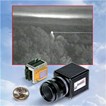Imaging In The Shortwave Infrared (SWIR) Spectrum Helps Track And Detect Lasers On The Battlefield

Click Here To Download:
•White Paper: Imaging In The Shortwave Infrared (SWIR) Spectrum Helps Track And Detect Lasers On The Battlefield
As warfare becomes more asymmetric, civilians and other non-combatants become a larger percentage of the casualties, along with unintended property damage. The military, of course, hopes to avoid these types of casualties and destruction. With advancing technologies that enable more precision from their weapons, they also need better pointing and targeting capabilities, while remaining covert. Improved targeting technologies that allow detection and identification at longer standoff distances from the designators are also needed. For instance, lasers are excellent at precision pointing but it is important thatothers be able to covertly image the scene as well.
To address these targeting challenges the military has deployed lasers which allow them to not only designate the target where munitions should hit but to use these same lasers to measure the distance to the target, illuminate the surrounding area, or point out to others something of interest. Visualizing where the lasers are pointing, tracking moving targets, and minimizing collateral damage requires imaging systems that see the active lasers used in the field. Room temperature indium gallium arsenide (InGaAs) cameras give users this capability in daytime and nighttime scenarios.
SOURCE: Sensors Unlimited Inc., An RTX Company
Click Here To Download:
•White Paper: Imaging In The Shortwave Infrared (SWIR) Spectrum Helps Track And Detect Lasers On The Battlefield
